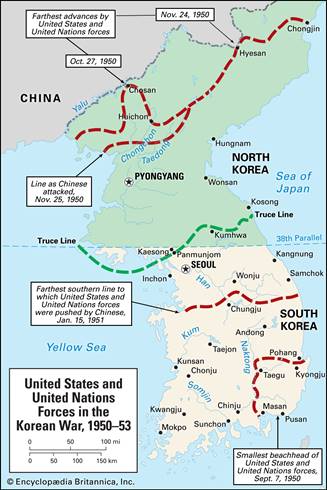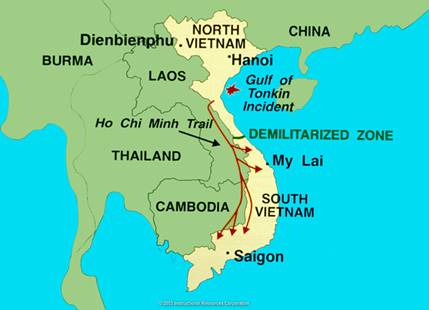The Cold War
(1945 - 1991)
Korea and Vietnam War
A Map of Korea

Figure 1: Korean War: United States and United
Nations Forces in the Korean War, 1950-1953. Image. Britannica
LaunchPacks, Encyclopedia Britannica, 8 Feb. 2020.
A Map of Vietnam

Figure 2† IRC, (2005) A Map of Vietnam. [Image].
Available from http://www.discoveryeducation.com.
†††† Content
Statement #25
The Cold War
and conflicts in Korea and Vietnam influenced domestic and international
politics.
††††††† Content Elaborations
1.
The Cold War dominated international politics and impacted domestic
policies in the United States for 45 years. Domestic and international concerns
during this period included:
a.
the Korean War;
b.
the Second Red Scare;
c.
the nuclear arms race;
d.
the Bay of Pigs Invasion and
Cuban Missile Crisis;
e.
political and military
intervention in the Middle East and Latin America;
f.
expansion of the role of the
United Nations; and
g.
the Vietnam War.
2.
The Korean War sparked international events and concerns that would
persist for decades, including:
a.
further tensions between the
United States and China; †
b.
the continued division of
North and South Korea; and
c.
improved relations and
diplomacy between the United States and Japan
3.
The Vietnam War divided the country and sparked massive protests. Major
domestic issues and events included:
a.
cuts to spending on domestic
programs;
b.
urban unrest and violence;
and
c.
anti-war protests.
Letís Practice:† Key Terms
††††††† Section A: Domestic and International Concerns
The tension
and rivalry between the United States and the Soviet Union were described as
the Cold War.† This was never a real war
between the sides, but both sides got involved in other conflicts around the
world.† United States' goal was to stop
the spread of communism around the world.†
After World
War II, many countries became communist.†
Soviet Union leader Joseph Stalin did not allow free elections in the ďDeclaration
of Liberated Europe.Ē† These countries
were East Germany, Poland, Czechoslovakia, Hungary, Romania, Bulgaria, and
Albania.† Communism expanded in Asia in
countries of North Korea, North Vietnam, and China.† Cuba developed into a communist country with
a totalitarian dictator named Fidel Castro.
|
Domestic Concerns |
International Concerns |
|
Second Red Scare |
Nuclear Arms Race |
|
McCarthyism |
Korean War |
|
Expansion role of
United Nations |
Bay of Pigs † |
|
Space Race |
Cuban Missile Crisis |
|
Spending on Science
Education |
Vietnam War |
Letís Practice:† Matching
Columns Game
††††††††††††††† Section B: Korean War
The Korean War sparked international events
and concerns that would persist for decades.†
These concerns were both positive and negative.
-† Negative:† †further tensions between the
United States and China
-† Negative:†
the continued division of North and South Korea
+ Positive:† improved
relations and diplomacy between the United States and Japan
After World
War II, the US attempted to curb Soviet influence on the Korean Peninsula by
occupying the southern part of that area. The area occupied by the US became
South Korea, while the other part became North Korea. North Korea soon passed
into the control of the Communist Party.
The People's
Republic of China and the Soviet Union lent their support to North Korea, while
the United States did the same to South Korea. On June 25, 1950, a large
military force moved across the 38th parallel in the Republic of Korea.
The fighting
ended on 27 July 1953, when the armistice agreement was signed. The agreement
restored the border between the Koreas near the 38th Parallel and created the
Korean Demilitarized Zone (DMZ) fortified buffer zone between the two Korean
nations.
Letís Practice:† Video
Quiz
Korean
War
Section C: Vietnam War
The Vietnam
War divided the country and sparked massive protests. Spending
for the war came at the expense of the domestic programs launched by President
Johnson. This led to urban unrest in the 1960s. The Vietnam War was
a dominant issue in the presidential campaigns of 1968 and 1972. The
difficulties and eventual withdrawal from Vietnam led to concerted efforts on
the part of the U.S. to find allies in future conflicts.
Major
domestic issues and events included:
ō cuts to spending on domestic programs
o War on Poverty
o Civil Right issues
ō urban unrest and violence
o Little Rock Central High School ŗ Civil Rights Incident ŗ Desegregation
o Race Riots broke out in American cities
o Anti-Poverty policies
ō anti-war protests
o Kent State University Incident ŗ four students were killed
o The anti-war movement was established at colleges and universities
Letís Practice:† Video
Quiz
Vietnam
War


